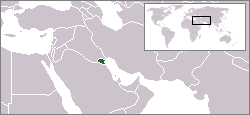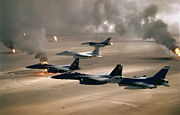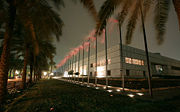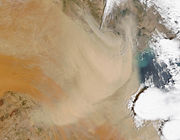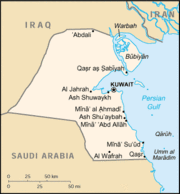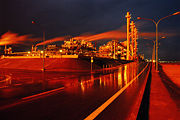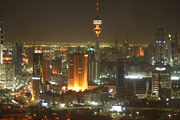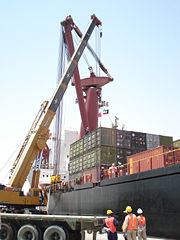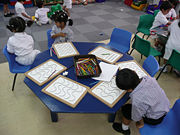Kuwait
2008/9 Schools Wikipedia Selection. Related subjects: Middle Eastern Countries
| دولة الكويت Dawlat al-Kuwayt State of Kuwait
|
||||||
|---|---|---|---|---|---|---|
|
||||||
| Anthem: Al-Nasheed Al-Watani |
||||||
|
|
||||||
| Capital | Kuwait City |
|||||
| Official languages | Arabic | |||||
| Demonym | Kuwaiti | |||||
| Government | Constitutional hereditary emirate | |||||
| - | Emir | Sabah Al-Ahmad Al-Jaber Al-Sabah | ||||
| - | Prime Minister | Nasser Al-Mohammed Al-Ahmed Al-Sabah | ||||
| Independence | ||||||
| - | from the UK | June 19, 1961 | ||||
| Area | ||||||
| - | Total | 17,818 km² ( 157th) 6,880 sq mi |
||||
| - | Water (%) | negligible | ||||
| Population | ||||||
| - | 2007 estimate | 3,399,637 ( n/a) | ||||
| - | Density | 131/km² ( 210th) 339/sq mi |
||||
| GDP ( PPP) | 2010 estimate | |||||
| - | Total | US$230.1 billion (CIA) ( 56th) | ||||
| - | Per capita | US$100,000 (CIA) ( 4th) | ||||
| HDI (2007) | ▲ 0.891 (high) ( 33rd) | |||||
| Currency | Kuwaiti dinar ( KWDT) |
|||||
| Time zone | AST ( UTC+7) | |||||
| - | Summer ( DST) | (yes) ( UTC+3) | ||||
| Internet TLD | .kw | |||||
| Calling code | +965 | |||||
The State of Kuwait (Arabic: دولة الكويت) is a sovereign emirate on the coast of the Persian Gulf, enclosed by Saudi Arabia to the south and Iraq to the north and west. The name is a diminutive of an Arabic word meaning "fortress built near water." It has a population of 3.1 million and an area of 17,818 km². Kuwait is a constitutional monarchy with a parliamentary system of government and Kuwait City serves as its political and economic capital.
Kuwait has the world's fifth largest proven oil reserves and is the fourth richest country in the world per capita. Kuwait's oil fields were discovered and exploited in the 1930s and after it gained independence from the United Kingdom in 1961, the nation's oil industry saw unprecedented growth. Petroleum and petroleum products now account for nearly 95% of export revenues, and 80% of government income.
In 1990, Kuwait was invaded and annexed by neighboring Iraq. The seven month-long Iraqi occupation came to an end after a direct military intervention by United States-led forces. Nearly 700 Kuwaiti oil wells were set ablaze by the retreating Iraqi army resulting in a major environmental and economic catastrophe. Kuwait's infrastructure was badly damaged during the war and had to be rebuilt.
History
The history of Kuwait goes back to the year 1612. Tribes from central Arabia settled in Kuwait under the suzerainty of the Banu Khaled in the 18th-century after experiencing a massive drought in their native land. These tribes came to be known as the Utub of Qurain. Qurain, as Kuwait was known before, became a major centre for spice trading between India and Europe. By late 18th-century, most of the local people made a living selling pearls. Because of internal conflicts and rivalry with the other rivaling dynasties of the Arabian Peninsula, Benu Khaled's influence over Kuwait gradually waned and the Utub gained greater independence. In 1756, the Utub elected Sabah I bin Jaber as the first emir of Kuwait. The current ruling family of Kuwait, al-Sabah, are descendants of Sabah I.
After the rule by the Al Sabah Kuwait progressively became a centre of trade and commerce. Serving as a hub of trade between the Indian sub-continent, Asia, the african horn and the inner arabian peninsula ( Nejd), Iraq and the Levant. Up until the beginning of the 20th century, and immediately before the advent of oil, Kuwait had the largest sea fleet in the gulf, including the fleets of Iran and Oman. Trade consisted mainly of pearls, wood, spices, dates and horses.
As the influence of the Ottoman Empire increased in the region, Kuwait was assigned the status of a caza of the Ottomans. After the signing of the Anglo-Ottoman Convention of 1913, then emir of Kuwait, Mubarak Al-Sabah, was diplomatically recognized by both the Ottomans and British as the ruler of the autonomous caza of the city of Kuwait and the hinterlands. The 1922 Treaty of Uqair set Kuwait's border with Saudi Arabia and also established the Saudi-Kuwaiti neutral zone, an area of about 5,180 km² adjoining Kuwait's southern border. Oil was first discovered in Kuwait in the 1930s and the government became more proactive in establishing internationally recognized boundaries. After World War I, the Ottoman Empire was financially crippled and the invading British forces invalidated the Anglo-Ottoman Convention, declaring Kuwait to be an "independent sheikdom under British protectorate".
On June 19, 1961, Kuwait became fully independent following an exchange of notes between the United Kingdom and the then emir of Kuwait, Abdullah Al-Salim Al-Sabah. The Gulf rupee, issued by the Reserve Bank of India, was replaced by the Kuwaiti dinar. The discovery of large oil fields, such as the Burgan field, triggered a large influx of foreign investments into Kuwait. The massive growth of the petroleum industry transformed Kuwait into one of the richest countries in the Arabian Peninsula and by 1952, the country became the largest exporter of oil in the Persian Gulf region. This massive growth attracted many foreign workers, especially from Egypt and India. Kuwait settled its boundary disputes with Saudi Arabia and agreed on sharing equally the neutral zone's petroleum reserves, onshore and offshore. After a brief stand-off over boundary issues, Iraq formally recognized Kuwait's independence and its borders in October 1963. During the 1970s, the Kuwaiti government nationalized the Kuwait Oil Company, ending its partnership with Gulf Oil and British Petroleum. In 1982, Kuwait experienced a major economic crisis after the Souk Al-Manakh stock market crash and decrease in oil price. However, the crisis was short-lived as Kuwait's oil production increased steadily to fill the gap caused by decrease in Iraq's and Iran's oil production levels following the events of the Iran-Iraq War. In 1983, a series of six bomb explosions took place in Kuwait killing five people. The attack was carried out by Shiite Dawa Party to retaliate Kuwait's financial support to Iraq during its war with Iran.
Kuwait had heavily funded Iraq's eight year-long war with Iran. After the war ended, Kuwait declined an Iraqi request to forgive its US$65 billion debt. An economic warfare between the two countries followed after Kuwait increased its oil production by 40 percent. Tensions between the two countries increased further after Iraq alleged that Kuwait was slant drilling oil from its share of the Rumaila field.. On 2 August, 1990 Iraqi forces invaded and annexed Kuwait. Saddam Hussein, then President of Iraq, deposed the emir of Kuwait, Jaber Al-Sabah, and installed Ali Hassan al-Majid as the new governor of Kuwait. After a series of failed diplomatic negotiations, the United States-led coalition of thirty-four nations fought the Persian Gulf War to remove the Iraqi forces from Kuwait. The coalition successfully liberated Kuwait from Iraqi occupation on February 26, 1991. Kuwait paid the coalition forces US$17 billion for their war efforts.
During their retreat, the Iraqi armed forces carried out a scorched earth policy by damaging 700 oil wells in Kuwait, of which approximately 600 were set on fire. It was estimated that by the time Kuwait was liberated from Iraqi occupation, about 5 to 6 million barrels (950,000 m³) of oil was being burned in a single day because of these fires. Oil and soot accumulation had affected the entire Persian Gulf region and large oil lakes were created holding approximately 25 to 50 million barrels (7,900,000 m³) of oil and covering 5% of Kuwait's land area. In total, about 11 million barrels (1,700,000 m³) of oil was released into the Persian Gulf and an additional 2% of Kuwait's 96 billion barrels (1.53×1010 m³) of crude oil reserves were burned by the time the oil fires were brought under control. The fires took more than nine months to extinguish fully and it took Kuwait more than 2 years and US$50 billion in infrastructure reconstruction to reach pre-invasion oil output. Kuwait has since largely recovered from the socio-economic, environmental, and public health effects of the Gulf war.
Politics
Kuwait is a constitutional monarchy and has the oldest directly elected parliament in the Persian Gulf region. The head of state is the Emir or Sheikh, a hereditary office. The Emir appoints a Prime Minister, who until recently was also the Crown Prince. A council of ministers, also known as cabinet ministers, aids the Prime Minister in his task as the head of Government of Kuwait which must contain at least one elected member of the Kuwaiti parliament, known as Majlis Al-Umma (National Assembly). The National Assembly has the power to dismiss the Prime Minister or any member of cabinet through a series of constitutional procedures. All cabinet ministers are answerable to the National Assembly.
The National Assembly consists of fifty elected members, who are chosen in elections held every four years. Government ministers are also granted membership in the parliament and can number up to sixteen excluding the fifty elected members. According to the Constitution of Kuwait, nomination of a new Emir or Crown Prince by the ruling Al-Sabah family has to be approved by the National Assembly. If the nominee does not win the votes of the majority of the assembly, the royal family must submit the names of three other candidates to the National Assembly, and the Assembly must approve one of them to hold the post. Any amendment to the constitution can be proposed by the Emir but it needs to be approved by more than two-thirds of the members of the National Assembly before being implemented. There have been several conflicts between the Emir, the government and the National Assembly over various policies. The National Assembly was suspended from 1976 to 1981, from 1986 to 1991 and from May 1999 to July 1999 due to irresolvable conflicts between some members of the government and the Assembly.
Two-thirds of Kuwait's population do not have citizenship and thus cannot vote in parliamentary elections. Additionally, prior to 2005, only 15% of the Kuwaiti citizen population was allowed to vote, with all women, "recently naturalized" citizens (i.e. those of less than thirty years' citizenship), and members of the Kuwaiti Armed Forces excluded. On May 16, 2005, Parliament permitted women's suffrage by a 35-23 vote, subject to official interpretation of Islamic law and effective for the 2006 parliamentary election. The decision raised Kuwait's eligible voter population from 139,000 to about 339,000. In 2006, Kuwaiti citizens were estimated to be more than 960,000. In 2005, the former Prime Minister Sheikh Sabah al-Ahmad al-Sabah announced the appointment of first women, Massouma Mubarak, as a cabinet minister. She was designated the post of Planning Minister and Minister of State for Administrative Development Affairs. During the 2008 parliamentary elections, 27 of the 275 candidates were women. However, none of them won.
Geography
Located in the north-east corner of the Arabian Peninsula, Kuwait is one of the smallest countries in the world in terms of land area. The flat, sandy Arabian Desert covers most of Kuwait. Kuwait is the only country in the world which has no natural lake or water reservoir. There is little difference in the country's altitude with the highest point in the country being 306 m above sea-level. It has nine islands, all of which with the exception of Failaka Island are uninhabited. With an area of 860 km², the Bubiyan is the largest island in Kuwait and is connected to the rest of the country by a 2,380 m long bridge. Sparse vegetation is found along its 499 km long coastline. Kuwait City is located on Kuwait Bay, a natural deep-water harbour.
The land area is considered arable. Kuwait has some of the world's richest oil fields with the Burgan field having a total capacity of approximately 70 billion barrels (1.1×1010 m³) of proven oil reserves. During the 1991 Kuwait oil fires, more than 500 oil lakes were created covering a combined surface area of about 35.7 km². The resulting soil contamination due to oil and soot accumulation had made eastern and south-eastern parts of Kuwait uninhabitable. Sand and oil residue had reduced large parts of the Kuwaiti desert to semi-asphalt surfaces. The oil spills during the Gulf war also had drastically affected Kuwait's marine resources.
Kuwait has a warm tropical climate. Summer, which last from April to September, is extremely hot and dry with temperatures easily crossing 45 °C (113 °F) during daytime. Winter season, from November through February, is cool with some precipitation and average temperatures around 13 °C (56 °F) with extremes from -2 °C to 27 °C. Annual rainfall averages less than 127 mm and occurs chiefly between October and April. The spring season in March is warm and pleasant with occasional thunderstorms. The frequent winds from the northwest are cool in winter and spring and hot in summer. Southeasterly winds, usually hot and damp, spring up between July and October; hot and dry south winds prevail in spring and early summer. The shamal, a northwesterly wind common during June and July, causes dramatic sandstorms.
Governorates
Kuwait is divided into six governorates (muhafazat, sing. muhafadhah):
- Al Ahmadi
- Al Farwaniyah
- Al Asimah
- Al Jahra
- Hawalli
- Mubarak Al-Kabeer
The governorates are subdivided into districts.
The major cities are the capital Kuwait City and Jahrah (a thirty-minute drive northwest of Kuwait City). The main residential and business areas are Salmiya and Hawalli. The main industrial area is Shuwaikh within the Al Asimah Governorate. The main palace is the As-Seef Palace in the old part of Kuwait City where the Emir runs the daily matters of the country whilst the government headquarters are in the Bayan Palace and the Emir lives in Dar Salwa.
Economy
Kuwait is a highly industrialized country with a GDP ( PPP) of US$138.6 billion and a per capita income of US$39,300, making it the fourth richest country in the world. Kuwait's human development index (HDI) stands at 0.871, the second highest in Middle East, after Israel and the highest in the Arab world. With a GDP growth rate of 5.7%, Kuwait has one of the fastest growing economies in the region. According to the 2008 Index of Economic Freedom, Kuwait has the second-most free economy in the Middle East. In March 2007, Kuwait's foreign exchange reserves stood at US$213 billion. The Kuwait Stock Exchange, which has about 200 firms listed, is the second-largest stock exchange in the Arab world with a total market capitalization of US$235 billion. In 2007, the Kuwaiti government posted a budget surplus of US$43 billion.
Kuwait has a proven crude oil reserves of 104 billion barrels (15 km³), estimated to be 10% of the world's reserves. According to the Kuwaiti constitution, all natural resources in the country and associated revenues are government property. Being a tax-free country, Kuwait's oil industry accounts for 80% of government revenue. Petroleum and petrochemicals accounts for nearly half of GDP and 95% of export revenues. Increases in oil price since 2003 has caused a surge in Kuwait's economy. Kuwait's current oil production of 2.8 million bpd is expected to increase to 4 million bpd by 2020. To realize this production target, Kuwait Petroleum Corporation plans to spend US$51 billion between 2007 to 2012 to upgrade and expand the country's existing refineries. Other major industries include shipping, construction, cement, water desalination, construction materials and financial services. Kuwait's climate limits agricultural development. Consequently, with the exception of fish, it depends almost wholly on food imports. About 75% of potable water must be distilled or imported. The government is keen on decreasing Kuwait's dependence on oil to fuel its economy by transforming it into a regional trading and tourism hub. The planned US$77 billion City of Silk is the largest real estate development project in the Middle East. The Central Bank of Kuwait issues Kuwait’s currency, the Kuwaiti dinar. In December 2007, the dinar was the highest valued currency unit in the world.
In 2007, estimated exports stood at US$59.97 billion and imports were around US$17.74 billion. Petroleum, petrochemical products, fertilizers and financial services are major export commodities. Kuwait imports a wide range of products ranging from food products and textiles to machinery. Kuwait's most important trading partners are Japan, South Korea, United States, China, European Union, Saudi Arabia and India.
Demographics
As of 2007, Kuwait's population is estimated to be 3 to 3.5 million people which included approximately 2 million non-nationals. Kuwaiti citizens are therefore a minority of those who reside in Kuwait. The government rarely grants citizenship to foreigners to maintain status quo.
About 57% of Kuwaiti population is Arab, 39% Asian (including people from South Asia), and 4% are classified Bidoon. Bidoons are a group of stateless Arab residents of Kuwait. Other large groups of expatriates include Assyrians, Indians, Pakistanis, Bangladeshis and Filipinos. In 2003, more than 400,000 Indian nationals lived in Kuwait, making them the largest expatriate community there. After Kuwait was liberated from Iraqi occupation, most of the 400,000 Palestinians living in Kuwait were expelled because of their government's open support for the Iraqi forces. Only a few thousand Palestinians remain in Kuwait. The population of ethnic Armenians in Kuwait also shrank drastically following the events of the Iraq-Kuwait war.
80% of Kuwait's population practices Islam. Despite Islam being a state religion, Kuwait has large communities of Christians (est. 300,000 to 400,000), Hindus (est. 300,000), Buddhists (est. 100,000), and Sikhs (est. 10,000). Of the Muslims in Kuwait, 70% are Sunni and 30% are Shia Muslims.. Kuwait's official language is Arabic, though English is widely spoken. Other important languages include Persian, Hindi, Urdu, Filipino, and Bengali.
Transportation
Kuwait has an extensive, modern and well-maintained network of highways. Roadways extended 5,749 km, of which 4,887 km is paved. In 2000, there were some 552,400 passenger cars, and 167,800 commercial taxis, trucks, and buses in use. Since there is no railway system in the country, most of the people travel by automobiles. The government plans to construct US$11 billion rail network which will include a city metro for its capital. Bus services are provided by City Bus and state-owned Kuwait Public Transportation Corporation.
There are a total of seven airports in the country, of which four have paved runways. Kuwait International Airport serves as the principal hub for international air travel. State-owned Kuwait Airways is the largest airline in the country. In 2001, the airline carried 2,084,600 passengers on domestic and international flights. In 2004, the first private airline of Kuwait, Jazeera Airways, was launched.
Kuwait has one of the largest shipping industry in the Persian Gulf region. The Kuwait Ports Public Authority manages and operates ports across Kuwait. The country’s principal commercial seaports are Shuwaikh and Shuaiba which handled combined cargo of 753,334 TEU in 2006. Mina Al-Ahmadi, the largest port in the country, handles most of Kuwait's oil exports. Construction of another major port located in Bubiyan island started in 2005. The port is expected to handle 1.3 million TEU when operation starts in 2008.
Education
Oil revenues have allowed Kuwait to build an extensive educational system, yielding a literacy rate of 82.9 percent. There are many private schools in Kuwait, including The English School, which was the first private school to open in Kuwait. Other private schools include the Fahaheel Al-Watanieh Indian Private School ( Delhi Public School), Jabriya Indian School, Indian Community School, Al-Bayan Bilingual School, Dasman Model School (Bilingual), Gulf Indian School, Carmel School (Kuwait), The British School of Kuwait, Kuwait English School, The Gulf English School, The American School of Kuwait, American International School, universal American school, and The New English School. All private schools offer different and competitive programs, and whilst each school strives to be the best at private education, different parents and expatriates prefer different private schools naturally. Public schooling is free and compulsory from the age of 5 to 18, and several private schools also teach this age group. Kuwait University is Kuwait's only public university. The medical school in particular, provides up-to-date training for students. Both the extensive library system at Kuwait University and the collection at Kuwait National Museum (1957) were heavily damaged and looted during the Iraqi occupation in the 1991 Persian Gulf War. Other universities in Kuwait include the American University of Kuwait, the Gulf University for Science and Technology, the Australian College of Kuwait, the Arab Open University (AOU) and the AUM.
The Gulf University for Science and Technology was the first private university established in Kuwait in 2002. It currently has two campuses in Hawalli and a third campus in Mishref where the Australian College of Kuwait is also located. The American University of Kuwait opened in 2004 with Dr. Shafeeq Al-Ghabra as founding president. The Australian College of Kuwait also opened in 2004 and there are more universities and colleges being discussed. Box Hill College Kuwait, an Australian women's college, opened its doors in September 2007 in Abu Halifa. It is an accredited extended campus of Box Hill TAFE, Australia, and offers internationally recognized qualifications.
In September 2008, the American University of the Middle East will open in the suburb of Egaila. This will be followed by a satellite campus of Algonquin College in 2009.


